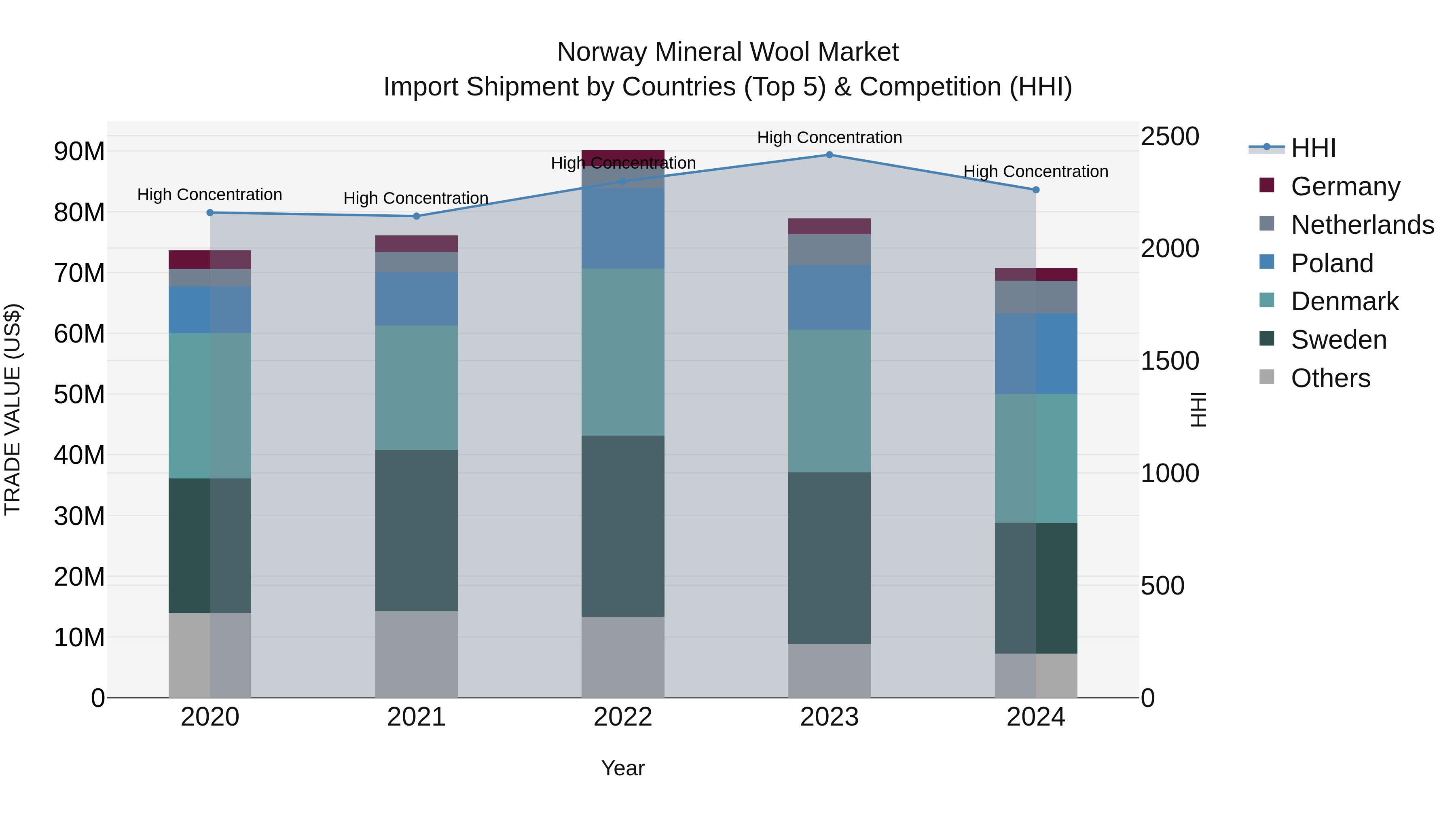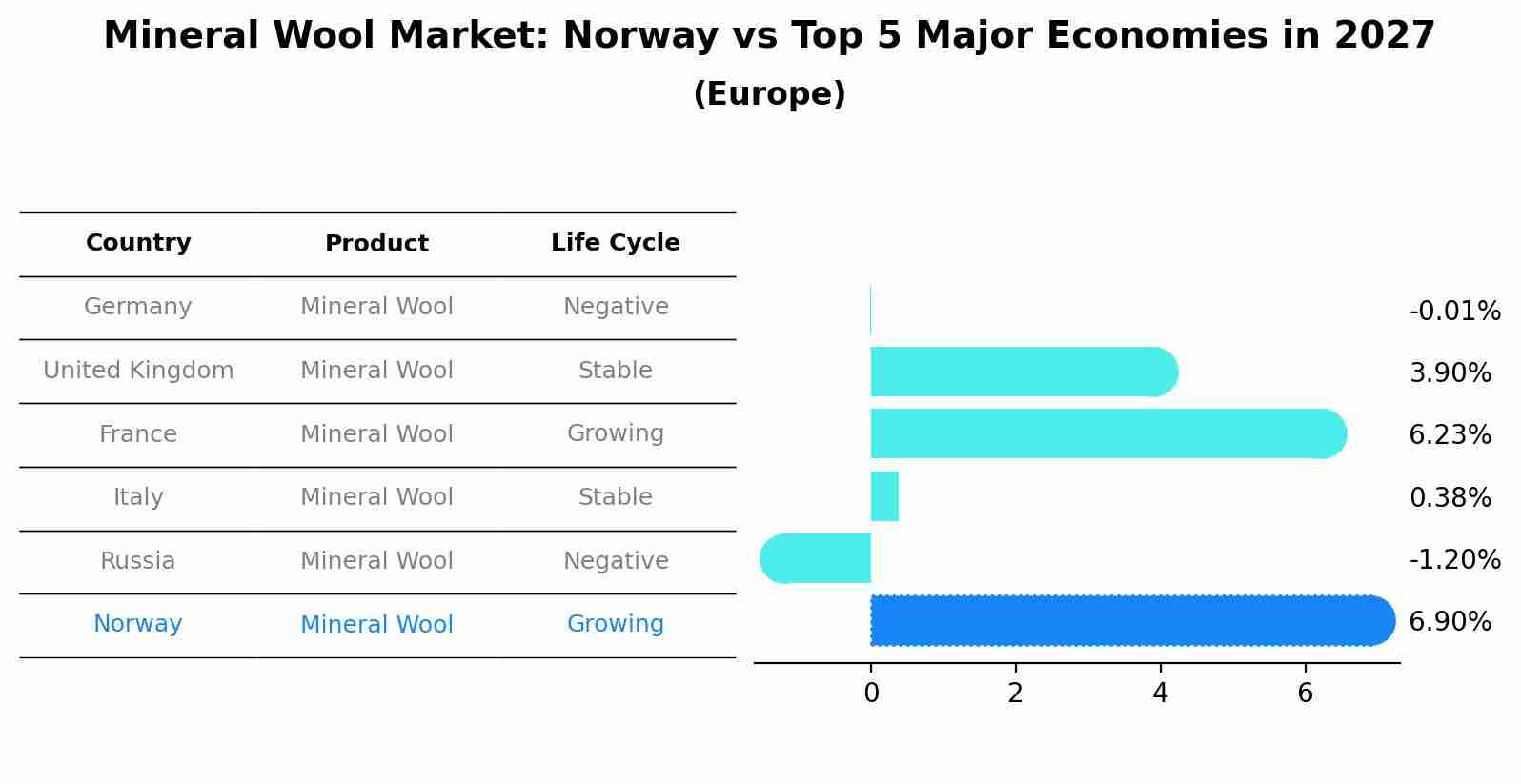Norway Mineral Wool Market (2025-2031) | Trends, Analysis, Value, Companies, Growth, Share, Revenue, Size, Industry, Segmentation, Outlook & Forecast
| Product Code: ETC4653353 | Publication Date: Nov 2023 | Updated Date: Nov 2025 | Product Type: Market Research Report | |
| Publisher: 6Wresearch | Author: Shubham Deep | No. of Pages: 60 | No. of Figures: 30 | No. of Tables: 5 |
Norway Mineral Wool Market Top 5 Importing Countries and Market Competition (HHI) Analysis
Norway`s mineral wool import market in 2024 continued to be dominated by neighboring countries such as Sweden, Denmark, and Poland, reflecting strong regional trade ties. Despite a negative compound annual growth rate (CAGR) of -1.03% from 2020 to 2024 and a significant decline in growth rate of -10.42% in 2024, the Herfindahl-Hirschman Index (HHI) indicated high concentration within the market. This suggests that while overall import volumes may have decreased, the market remains relatively consolidated among key exporting countries, highlighting the importance of strategic partnerships and competitive pricing strategies for market players.

Mineral Wool Market: Norway vs Top 5 Major Economies in 2027 (Europe)
By 2027, the Mineral Wool market in Norway is anticipated to reach a growth rate of 6.90%, as part of an increasingly competitive Europe region, where Germany remains at the forefront, supported by United Kingdom, France, Italy and Russia, driving innovations and market adoption across sectors.

Norway Mineral Wool Market Overview
The mineral wool market in Norway is expanding, particularly due to the focus on energy-efficient building materials. Mineral wool is widely used in construction for its insulation properties, and with growing environmental concerns, the demand for sustainable, fire-resistant materials is on the rise.
Drivers of the market
The mineral wool market in Norway is driven by the increasing focus on energy efficiency and sustainable construction practices. The demand for high-performance insulation materials, particularly in building applications that require enhanced thermal and acoustic insulation, contributes significantly to market growth.
Challenges of the market
The mineral wool market in Norway is challenged by environmental concerns regarding the sustainability of raw materials. Furthermore, the high energy consumption in the production process and rising competition from alternative insulation materials also present hurdles.
Government Policy of the market
The Norwegian government regulates the mineral wool market through policies aimed at promoting energy efficiency in building materials. There are specific guidelines on the use of mineral wool for insulation in construction, aligning with Norways environmental goals to reduce energy consumption. Policies also provide financial incentives for the use of sustainable and recyclable materials in manufacturing mineral wool.
Key Highlights of the Report:
- Norway Mineral Wool Market Outlook
- Market Size of Norway Mineral Wool Market, 2024
- Forecast of Norway Mineral Wool Market, 2031
- Historical Data and Forecast of Norway Mineral Wool Revenues & Volume for the Period 2021-2031
- Norway Mineral Wool Market Trend Evolution
- Norway Mineral Wool Market Drivers and Challenges
- Norway Mineral Wool Price Trends
- Norway Mineral Wool Porter`s Five Forces
- Norway Mineral Wool Industry Life Cycle
- Historical Data and Forecast of Norway Mineral Wool Market Revenues & Volume By Product Type for the Period 2021-2031
- Historical Data and Forecast of Norway Mineral Wool Market Revenues & Volume By Rock Wool for the Period 2021-2031
- Historical Data and Forecast of Norway Mineral Wool Market Revenues & Volume By Glass Wool for the Period 2021-2031
- Historical Data and Forecast of Norway Mineral Wool Market Revenues & Volume By Form Types for the Period 2021-2031
- Historical Data and Forecast of Norway Mineral Wool Market Revenues & Volume By Board for the Period 2021-2031
- Historical Data and Forecast of Norway Mineral Wool Market Revenues & Volume By Blankets for the Period 2021-2031
- Historical Data and Forecast of Norway Mineral Wool Market Revenues & Volume By Panel for the Period 2021-2031
- Historical Data and Forecast of Norway Mineral Wool Market Revenues & Volume By Others for the Period 2021-2031
- Historical Data and Forecast of Norway Mineral Wool Market Revenues & Volume By Applications for the Period 2021-2031
- Historical Data and Forecast of Norway Mineral Wool Market Revenues & Volume By Building & Construction for the Period 2021-2031
- Historical Data and Forecast of Norway Mineral Wool Market Revenues & Volume By Industrial for the Period 2021-2031
- Historical Data and Forecast of Norway Mineral Wool Market Revenues & Volume By Transportation for the Period 2021-2031
- Historical Data and Forecast of Norway Mineral Wool Market Revenues & Volume By Others for the Period 2021-2031
- Norway Mineral Wool Import Export Trade Statistics
- Market Opportunity Assessment By Product Type
- Market Opportunity Assessment By Form Types
- Market Opportunity Assessment By Applications
- Norway Mineral Wool Top Companies Market Share
- Norway Mineral Wool Competitive Benchmarking By Technical and Operational Parameters
- Norway Mineral Wool Company Profiles
- Norway Mineral Wool Key Strategic Recommendations
Frequently Asked Questions About the Market Study (FAQs):
1 Executive Summary |
2 Introduction |
2.1 Key Highlights of the Report |
2.2 Report Description |
2.3 Market Scope & Segmentation |
2.4 Research Methodology |
2.5 Assumptions |
3 Norway Mineral Wool Market Overview |
3.1 Norway Country Macro Economic Indicators |
3.2 Norway Mineral Wool Market Revenues & Volume, 2021 & 2031F |
3.3 Norway Mineral Wool Market - Industry Life Cycle |
3.4 Norway Mineral Wool Market - Porter's Five Forces |
3.5 Norway Mineral Wool Market Revenues & Volume Share, By Product Type, 2021 & 2031F |
3.6 Norway Mineral Wool Market Revenues & Volume Share, By Form Types, 2021 & 2031F |
3.7 Norway Mineral Wool Market Revenues & Volume Share, By Applications, 2021 & 2031F |
4 Norway Mineral Wool Market Dynamics |
4.1 Impact Analysis |
4.2 Market Drivers |
4.2.1 Growing construction industry in Norway leading to increased demand for insulation materials like mineral wool |
4.2.2 Stringent government regulations promoting energy efficiency in buildings, driving the adoption of mineral wool insulation |
4.2.3 Rising awareness among consumers about the benefits of using sustainable and eco-friendly insulation materials like mineral wool |
4.3 Market Restraints |
4.3.1 Fluctuating raw material prices impacting the production cost of mineral wool |
4.3.2 Competition from alternative insulation materials like fiberglass or foam insulation |
4.3.3 Economic uncertainties and fluctuations affecting investment in construction projects using mineral wool insulation |
5 Norway Mineral Wool Market Trends |
6 Norway Mineral Wool Market Segmentations |
6.1 Norway Mineral Wool Market, By Product Type |
6.1.1 Overview and Analysis |
6.1.2 Norway Mineral Wool Market Revenues & Volume, By Rock Wool, 2021-2031F |
6.1.3 Norway Mineral Wool Market Revenues & Volume, By Glass Wool, 2021-2031F |
6.2 Norway Mineral Wool Market, By Form Types |
6.2.1 Overview and Analysis |
6.2.2 Norway Mineral Wool Market Revenues & Volume, By Board, 2021-2031F |
6.2.3 Norway Mineral Wool Market Revenues & Volume, By Blankets, 2021-2031F |
6.2.4 Norway Mineral Wool Market Revenues & Volume, By Panel, 2021-2031F |
6.2.5 Norway Mineral Wool Market Revenues & Volume, By Others, 2021-2031F |
6.3 Norway Mineral Wool Market, By Applications |
6.3.1 Overview and Analysis |
6.3.2 Norway Mineral Wool Market Revenues & Volume, By Building & Construction, 2021-2031F |
6.3.3 Norway Mineral Wool Market Revenues & Volume, By Industrial, 2021-2031F |
6.3.4 Norway Mineral Wool Market Revenues & Volume, By Transportation, 2021-2031F |
6.3.5 Norway Mineral Wool Market Revenues & Volume, By Others, 2021-2031F |
7 Norway Mineral Wool Market Import-Export Trade Statistics |
7.1 Norway Mineral Wool Market Export to Major Countries |
7.2 Norway Mineral Wool Market Imports from Major Countries |
8 Norway Mineral Wool Market Key Performance Indicators |
8.1 Energy efficiency ratings of buildings using mineral wool insulation |
8.2 Number of new construction projects incorporating mineral wool insulation |
8.3 Adoption rate of mineral wool insulation in residential and commercial buildings |
9 Norway Mineral Wool Market - Opportunity Assessment |
9.1 Norway Mineral Wool Market Opportunity Assessment, By Product Type, 2021 & 2031F |
9.2 Norway Mineral Wool Market Opportunity Assessment, By Form Types, 2021 & 2031F |
9.3 Norway Mineral Wool Market Opportunity Assessment, By Applications, 2021 & 2031F |
10 Norway Mineral Wool Market - Competitive Landscape |
10.1 Norway Mineral Wool Market Revenue Share, By Companies, 2024 |
10.2 Norway Mineral Wool Market Competitive Benchmarking, By Operating and Technical Parameters |
11 Company Profiles |
12 Recommendations | 13 Disclaimer |
- Single User License$ 1,995
- Department License$ 2,400
- Site License$ 3,120
- Global License$ 3,795
Search
Thought Leadership and Analyst Meet
Our Clients
Related Reports
- Germany Breakfast Food Market (2026-2032) | Industry, Share, Growth, Size, Companies, Value, Analysis, Revenue, Trends, Forecast & Outlook
- Australia Briquette Market (2025-2031) | Growth, Size, Revenue, Forecast, Analysis, Trends, Value, Share, Industry & Companies
- Vietnam System Integrator Market (2025-2031) | Size, Companies, Analysis, Industry, Value, Forecast, Growth, Trends, Revenue & Share
- ASEAN and Thailand Brain Health Supplements Market (2025-2031) | Strategy, Consumer Insights, Analysis, Investment Trends, Opportunities, Growth, Size, Share, Industry, Revenue, Segments, Value, Segmentation, Supply, Forecast, Restraints, Outlook, Competition, Drivers, Trends, Demand, Pricing Analysis, Competitive, Strategic Insights, Companies, Challenges
- ASEAN Bearings Market (2025-2031) | Strategy, Consumer Insights, Analysis, Investment Trends, Opportunities, Growth, Size, Share, Industry, Revenue, Segments, Value, Segmentation, Supply, Forecast, Restraints, Outlook, Competition, Drivers, Trends, Demand, Pricing Analysis, Competitive, Strategic Insights, Companies, Challenges
- Europe Flooring Market (2025-2031) | Outlook, Share, Industry, Trends, Forecast, Companies, Revenue, Size, Analysis, Growth & Value
- Saudi Arabia Manlift Market (2025-2031) | Outlook, Size, Growth, Trends, Companies, Industry, Revenue, Value, Share, Forecast & Analysis
- Uganda Excavator, Crane, and Wheel Loaders Market (2025-2031) | Strategy, Consumer Insights, Analysis, Investment Trends, Opportunities, Growth, Size, Share, Industry, Revenue, Segments, Value, Segmentation, Supply, Forecast, Restraints, Outlook, Competition, Drivers, Trends, Demand, Pricing Analysis, Competitive, Strategic Insights, Companies, Challenges
- Rwanda Excavator, Crane, and Wheel Loaders Market (2025-2031) | Strategy, Consumer Insights, Analysis, Investment Trends, Opportunities, Growth, Size, Share, Industry, Revenue, Segments, Value, Segmentation, Supply, Forecast, Restraints, Outlook, Competition, Drivers, Trends, Demand, Pricing Analysis, Competitive, Strategic Insights, Companies, Challenges
- Kenya Excavator, Crane, and Wheel Loaders Market (2025-2031) | Strategy, Consumer Insights, Analysis, Investment Trends, Opportunities, Growth, Size, Share, Industry, Revenue, Segments, Value, Segmentation, Supply, Forecast, Restraints, Outlook, Competition, Drivers, Trends, Demand, Pricing Analysis, Competitive, Strategic Insights, Companies, Challenges
Industry Events and Analyst Meet
Whitepaper
- Middle East & Africa Commercial Security Market Click here to view more.
- Middle East & Africa Fire Safety Systems & Equipment Market Click here to view more.
- GCC Drone Market Click here to view more.
- Middle East Lighting Fixture Market Click here to view more.
- GCC Physical & Perimeter Security Market Click here to view more.
6WResearch In News
- Doha a strategic location for EV manufacturing hub: IPA Qatar
- Demand for luxury TVs surging in the GCC, says Samsung
- Empowering Growth: The Thriving Journey of Bangladesh’s Cable Industry
- Demand for luxury TVs surging in the GCC, says Samsung
- Video call with a traditional healer? Once unthinkable, it’s now common in South Africa
- Intelligent Buildings To Smooth GCC’s Path To Net Zero


















